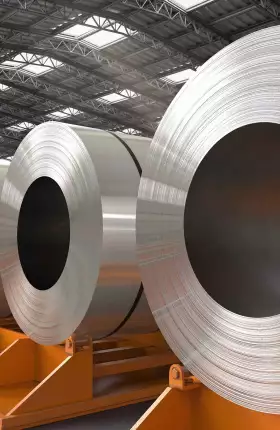Even before President Donald Trump formally unveiled his stiff US protective import tariffs on steel and aluminum, the impact was starting to be felt by North American manufacturers. Companies that need steel for their products told BCG that US mills were asking them to book orders several months in advance to reserve production capacity.
The full consequences of the Trump tariffs, which are to take effect on March 23, will unfold in the months ahead, as duties of 25% on steel and 10% on aluminum ripple through global supply chains and as additional details emerge. It remains to be seen, for example, what the US will demand from Canada and Mexico in return for continuing to exempt them from the tariffs. Other consequences will depend how other nations respond, what additional actions the Trump Administration might take to achieve its stated goal of slashing the US trade deficit, and how corporations adapt their global production footprints and investments.
The severity of the US policy shift underscores the urgency with which business leaders—and not only those directly affected by the tariffs—must prepare for change in the world trade regime. Companies must assess the risks and opportunities that the altered trade rules create in their global value chains, develop plans of action based on various potential outcomes, and work proactively to influence policy.
Winners and Losers in the New Tariff Regime
The most immediate winners will be US producers of steel and aluminum—and for the time being, Canadian and Mexican producers as well. US companies that use those metals as inputs, and the consumers of their products, will pay the biggest price.
Our quick calculations, based on Commerce Department assumptions, indicate that US steel prices could rise by 7%. The actual increase could easily be much higher, especially in the short term. For example, prices could rise to the levels of steel imports on which the tariff has been levied. Another consideration is that much of the steel that US companies import, such as for the oil and gas industry, is of a very specific type and has stringent certification requirements. It will therefore be difficult for manufacturers to shift from one rolling mill to another even if both are owned by the same company—let alone switch to a new supplier. And even if a domestic supplier is available, the certification process can be long. As a result, many US buyers will have no immediate alternative but to pay more for the imported steel.
Still, US steel production is expected to expand by around 10%, while US imports of tariff-free Canadian and Mexican steel will also rise by around 10%. Steel imports from other nations will drop by 40%. Brazilian and South Korean producers, one-third of whose worldwide exports are absorbed by the US, will be hit hardest.
US aluminum production will need to increase even more, doubling in volume to achieve the domestic capacity utilization goal set by the administration. Imports currently account for around 90% of US aluminum consumption. The US will import less aluminum overall, but shipments from Canada will likely increase. Canada already accounts for 43% of US aluminum imports, an amount equal to roughly four times the production of the entire US aluminum industry. Mexican aluminum makers, which now supply just 1.5% of US imports, will also gain. Aluminum imports from Russia, China, the United Arab Emirates, and other suppliers will plunge.
The tariffs will spur investment and create jobs in the US steel- and aluminum-producing industries, but only modestly in absolute numbers. The need to expand US production will be limited: US steel makers overall are currently operating at only 72% of capacity, while integrated steel plants are operating at only 40%. The US aluminum industry is also producing at just 40% of capacity. What’s more, technological advances have made these sectors dramatically more efficient and have reduced their employment needs.
Who Will Pay the Price?
Construction companies and manufacturers of transportation equipment such as motor vehicles are the heaviest users of steel and aluminum. Producers of machinery, packaging, and electronics are also major customers. In industries such as construction, where competition is domestic, the higher costs of raw materials will be passed on to customers. Where competition is global, the higher input costs will put companies that manufacture in the US for export at a disadvantage.
Swedish global appliance maker Electrolux has already said it will postpone a planned $250 million investment in Tennessee, telling a local newspaper, The Tennessean, that the tariff decision “gives foreign manufacturers a cost advantage that is hard to compete against.” Meanwhile, component producers in Canada, Mexico, and elsewhere stand to benefit from the new cost advantage they will enjoy over competitors that manufacture in the US, which will have to pay more for steel and aluminum.
Given the size of the affected industries, the negative impact on US employment and investment will likely far outweigh employment gains in the steel and aluminum sectors. A study by two trade economists on the steel tariffs imposed in 2002 by the George W. Bush administration—which likewise exempted Canada and Mexico—estimated a net loss of between 50,000 and 200,000 US jobs in user industries, while employment in the steel industry continued to decline.
The Risk of Retaliation
Retaliatory measures by US trade partners are likely to follow, and a number of export industries unrelated to steel or aluminum are likely to get caught in the crossfire.
The European Union has already announced its readiness to impose retaliatory tariffs that would affect such important US products as Harley-Davidson motorcycles, Kentucky bourbon, and agricultural products like Florida orange juice. The targets are being chosen for maximum political impact, and will aim to impose economic costs similar to those suffered by European steel and aluminum producers.
The nations of the EU and others will likely challenge the tariffs through the World Trade Organization (WTO), and will move to safeguard their own steel and aluminum markets against a surge of imports from countries that otherwise would be exporting to the US. Other countries affected by the US tariffs, such as China, Brazil, and Russia, can be expected to evaluate their responses as well.
Prepare for Greater Trade Friction: No Longer Business as Usual
Companies must revise their expectations about what US trade policy, and possibly the world’s trading system, will look like in the future. If tariffs on steel and aluminum were the only big trade-related threat facing global companies, the challenges would be manageable, especially for those not directly or indirectly affected.
But we believe that these US actions may not only be a harbinger of more aggressive trade policies, but could also push the global trading system further down the slippery slope of protectionism. While there has been some momentum toward trade liberalization—such as the Comprehensive Economic and Trade Agreement between Canada and the EU and the 11-nation Comprehensive and Progressive Agreement for Trans-Pacific Partnership—there are also clear signs of protectionism in many parts of the world. The US tariffs on steel and aluminum play into this trend in three important ways.
First, the move confirms that President Trump will not merely engage in rhetoric on trade policy but will increasingly act. He has consistently expressed deep concern about past US policy. This skepticism was reflected in the US Trade Policy Agenda that he sent to Congress in 2017, and it drove the administration’s earlier decisions to leave the Trans-Pacific Partnership, renegotiate the North American Free Trade Agreement and the US–South Korea trade agreements, and openly question the benefits of the WTO. But there was still hope that Trump’s actual decisions would be more aligned with open trade as an ultimate US policy objective. Now, there is uncertainty.
The next move to watch in this pattern is the Commerce Department’s assessment of whether Chinese companies have systematically violated US intellectual property rights. The outcome of this process will almost certainly lead to a heightening of the already tense relationship between the US and China. In addition, Trump has recently singled out other industries, such as automobiles, in which the US might unilaterally impose high duties if the EU and other trading partners don’t treat the US “fairly.”
A second major concern is the specific way in which the steel and aluminum tariffs were enacted. The administration cited Section 232 of the Trade Expansion Act of 1962, which provides leeway for imposing restrictions in the name of national security, as opposed to using other mechanisms that would involve Congress. This is permissible under WTO rules, but the principle is rarely invoked because it is vaguely defined and could erode rules-based checks on protectionist actions taken unilaterally. It is also interesting to note that the administration regards steel imports from fellow NATO members as a national security threat. Playing the national-security card on steel opens to the door to other sector-specific tariffs imposed on the basis of the same principle.
A third concern relates to the broader global trading system. Since the Second World War, many multilateral institutions, including the General Agreement on Tariffs and Trade and its successor, the WTO, were established under US leadership precisely to prevent tit-for-tat tariffs and trade wars. With the US now unwilling to play this role, descent into a significantly more protectionist trade environment is at least more likely. Even outside of the US, voices calling for greater protectionism will be emboldened, while trade liberalization will be politically harder to sustain.
In the short to medium term, companies must assume that trade involving the US will be subject to more friction. Whether this trend becomes truly global is less certain. Nevertheless, rising economic nationalism around the world means that companies should take action now to adapt to a less open international business landscape.
What Companies Can Do
As we have suggested in previous publications, CEOs of companies whose businesses depend on global trade should undertake several steps immediately. (See “ How to Thrive in an Era of Shifting Trade Policy, ” BCG article, June 2017.)
Companies should begin by assessing their exposure to rising steel and aluminum prices in the US and the impact on their cost structures. They should determine the share of steel and aluminum in total production costs, the likely effect of tariffs on their current suppliers, and whether or not the added costs can be passed on to consumers. Companies should stress-test their value chains under scenarios of escalating trade protectionism, such as whether or not tariffs are levied on all countries and producers and whether or not protectionist measures spread to other sectors, such as automobiles and electronics.
Companies should then develop a game plan for adapting to the new trade regime under different scenarios. They should explore changing the global footprint of their operations, particularly with respect to serving the US and other major markets, and understand the implications of those changes for costs and market access. Potential responses should go beyond tactical moves. Companies should also reassess their operations and find opportunities to increase their resilience and agility so that they can react to external shocks and shifting trade rules without sacrificing efficiency or the ability to pursue market opportunities. To prepare for potential future shocks, they should develop their capacity to gather intelligence on geopolitical and macroeconomic shifts.
Finally, companies involved in cross-border trade should review their strategy for public engagement on trade policy. They should explore ways to better communicate with policymakers, stakeholders, and the public at large on the benefits of global trade and foreign investment—and how changes that restrict them will directly affect local communities, industries, and workers. They should identify allies across industries and society and speak more effectively with a common voice, rather than from narrow self-interest. Perhaps even more important, companies should resist the temptation to exploit the openings created by a less rules-based trade environment to push for narrow firm- or industry-specific advantages. These might seem beneficial in the short term but will erode the broader business environment over time.
For the foreseeable future, the contours of the global trade and economic environment are likely to remain in flux. Companies that take an informed, proactive, and comprehensive approach to adapting to changes in trade rules will be in the strongest position to both minimize the risks and seize a competitive advantage.
The BCG Henderson Institute is Boston Consulting Group’s strategy think tank, dedicated to exploring and developing valuable new insights from business, technology, and science by embracing the powerful technology of ideas. The Institute engages leaders in provocative discussion and experimentation to expand the boundaries of business theory and practice and to translate innovative ideas from within and beyond business. For more ideas and inspiration from the Institute, please visit
Featured Insights
.











